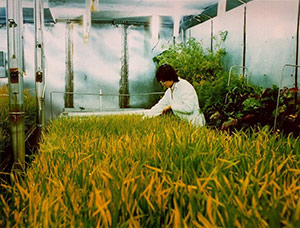
BIOS-3 – BIOlogical closed life support System

Its construction began in 1965, and was completed in 1972. BIOS-3 consists of a 315 cubic meter habitat suitable for up to three persons, and was initially used for developing closed ecosystems capable of supporting humans. It was divided into 4 compartments — one of which is a crew area. Initially one other compartment was an algal cultivator, and the other two "phytotrons" for growing wheat or vegetables. Later the algal cultivator was converted into a third phytotron. A level of light comparable to sunlight was supplied in each of the four compartments by 20 kW xenon lamps, cooled by water jackets. The facility used 400 kW of electricity.
Chlorella algae were used to recycle air breathed by humans, absorbing carbon dioxide and replenishing it with oxygen through photosynthesis. The algae were cultivated in stacked tanks under artificial light. To achieve a balance of oxygen and carbon dioxide, one human needed 8 m2 of exposed Chlorella. Air was purified from more complex organic compounds by heating to 600°C in the presence of a catalyst. Water and nutrients were stored in advance and were also recycled.

By 1968, system efficiency had reached 99% by recycling the air, 85% by recycling water and about 50% by recycling food and nutrients. Dried meat was imported into the facility to balance the diet, urine and feces were partially recycled and partially dried and stored.
BIOS-3 facilities were used to conduct 10 manned closure experiments with a one to three man crew. The longest experiment with a three man crew lasted 180 days (in 1972-1973). The facilities were used for the tests at least until 1984.
In 1991, BIOS-3 became a part of the International Center for Closed Ecosystems, which was formed as a subdivision of Institute of Biophysics (Russian Academy of Sciences, Siberian Branch). Closed ecosystems research focusing on growing plants and recycling waste was resumed in 2005 in cooperation with European Space Agency.

Related links
BIOS-3 at the Wikipedia
BIOS-3 facility as a part of the BIOSMHARS (BIOcontamination Specific Modelling in HAbitats Related to Space) project
Man-Made Closed Ecological Systems
(J.I. Gitelson, G.M. Lisovsky and R.D. MacElroy, Taylor and Francis (CRC Press), 2003, ISBN 10: 0415299985 / ISBN 13: 9780415299985, 402 pages)
Bios-3: Siberian experiments in bioregenerative life support - Attempts to purify air and grow food for space exploration in a sealed environment began in 1972
(Salisbury F.B.; Gitelson J.I.; Lisovsky G.M., BioScience, 1997, 47 (9): 575-585)
|





